Abstract
Hemodynamics and myocardial metabolism were evaluated in 18 patients in cardiogenic shock following acute myocardial infarction. The response to l-norepinephrine was studied in seven cases and the response to isoproterenol in four cases. Cardiac index (CI) was markedly reduced, averaging 1.35 liters/min per m2. Mean arterial pressure ranged from 40 to 65 mm Hg while systemic vascular resistance varied widely, averaging 1575 dyne-sec-cm-5. Coronary blood flow (CBF) was decreased in all but three patients (range 60-95, mean 71 ml/100 g per min). Myocardial oxygen consumption (MVO2) was normal or increased ranging from 5.96 to 11.37 ml/100 g per min. Myocardial oxygen extraction was above 70% and coronary sinus oxygen tension was below 22 mm Hg in most of the patients. The detection of the abnormal oxygen pattern in spite of sampling of mixed coronary venous blood indicates the severity of myocardial hypoxia. In 15 studies myocardial lactate production was demonstrated; in the remaining three lactate extraction was below 10%. Excess lactate was present in 12 patients. During l-norepinephrine infusion CI increased insignificantly. Increased arterial pressure was associated in all patients by increases in CBF, averaging 28% (P < 0.01). Myocardial metabolism improved. Increases in MVO2 mainly paralled increases in CBF. Myocardial lactate production shifted to extraction in three patients and extraction improved in three. During isoproterenol infusion CI increased uniformly, averaging 61%. Mean arterial pressure remained unchanged but diastolic arterial pressure fell. CBF increased in three patients, secondary to decrease in CVR. Myocardial lactate metabolism deteriorated uniformly; lactate production increased or extraction shifted to production. In the acute state of coronary shock the primary therapeutic concern should be directed towards the myocardium and not towards peripheral circulation. Since forward and collateral flow through the severely diseased coronary bed depends mainly on perfusion pressure, l-norepinephrine appears to be superior to isoproterenol; phase-shift balloon pumping may be considered early when pharmacologic therapy is unsuccessful.
Full text
PDF
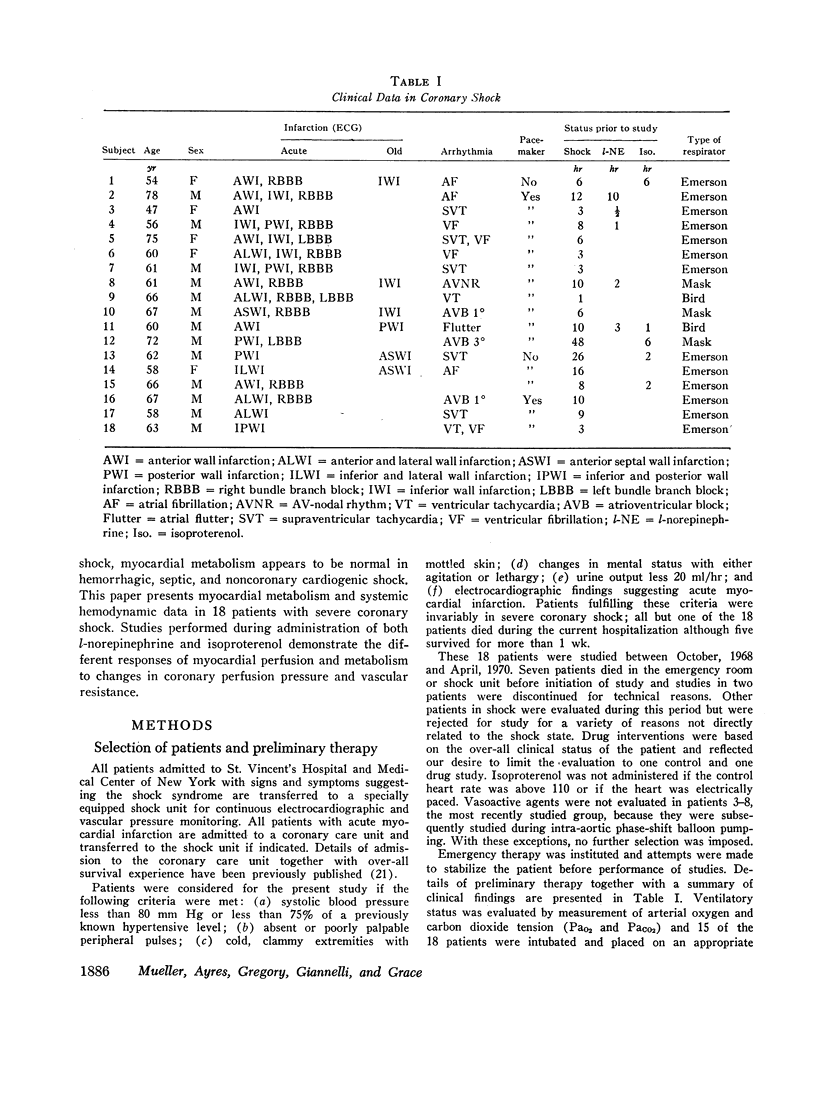
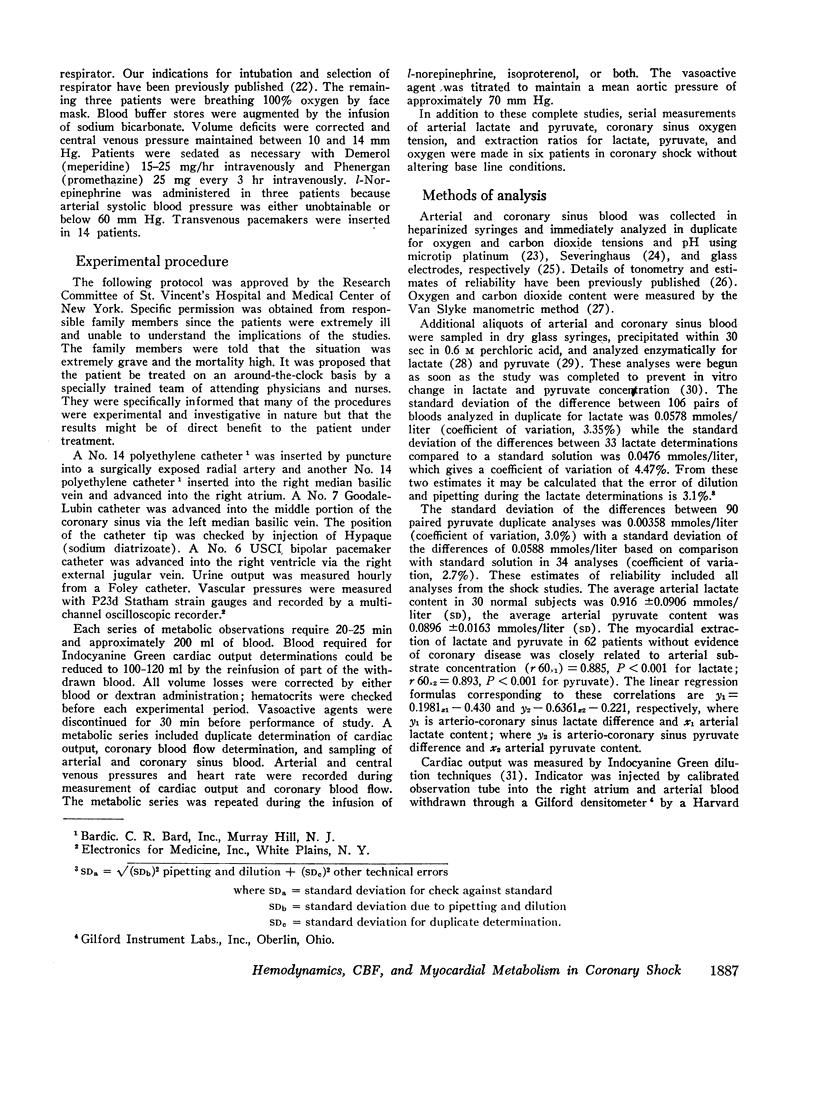
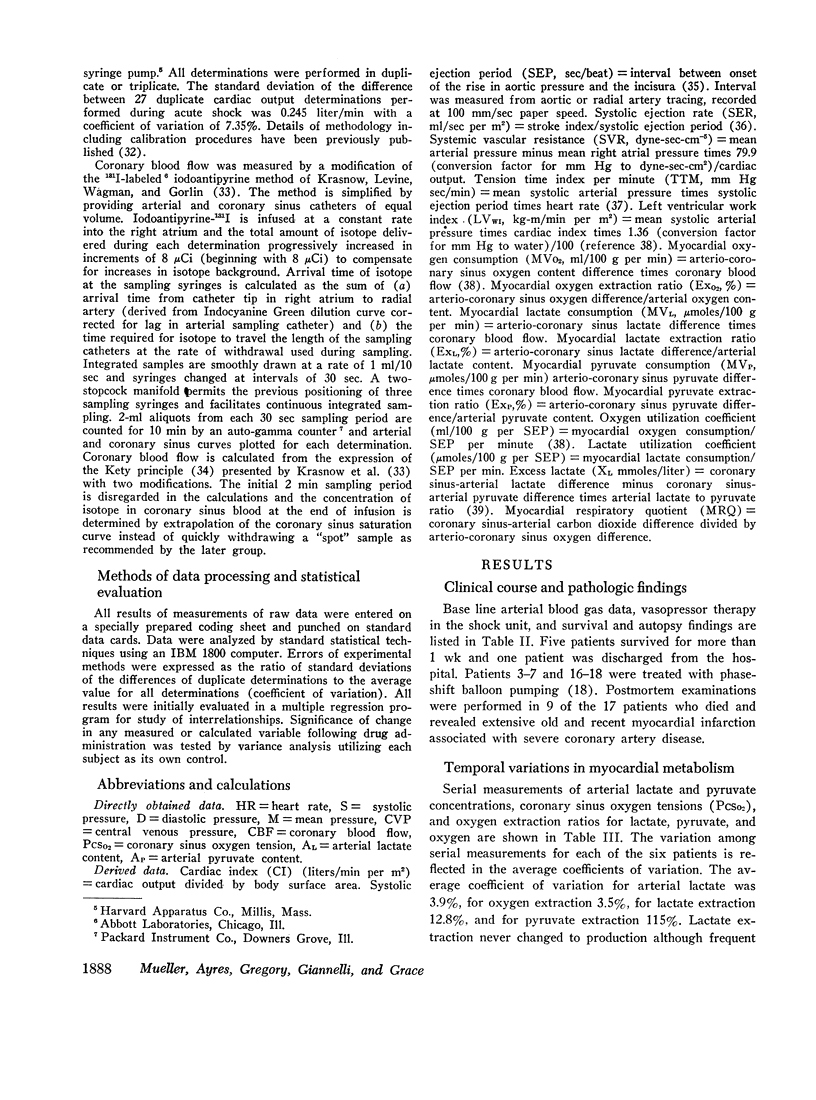
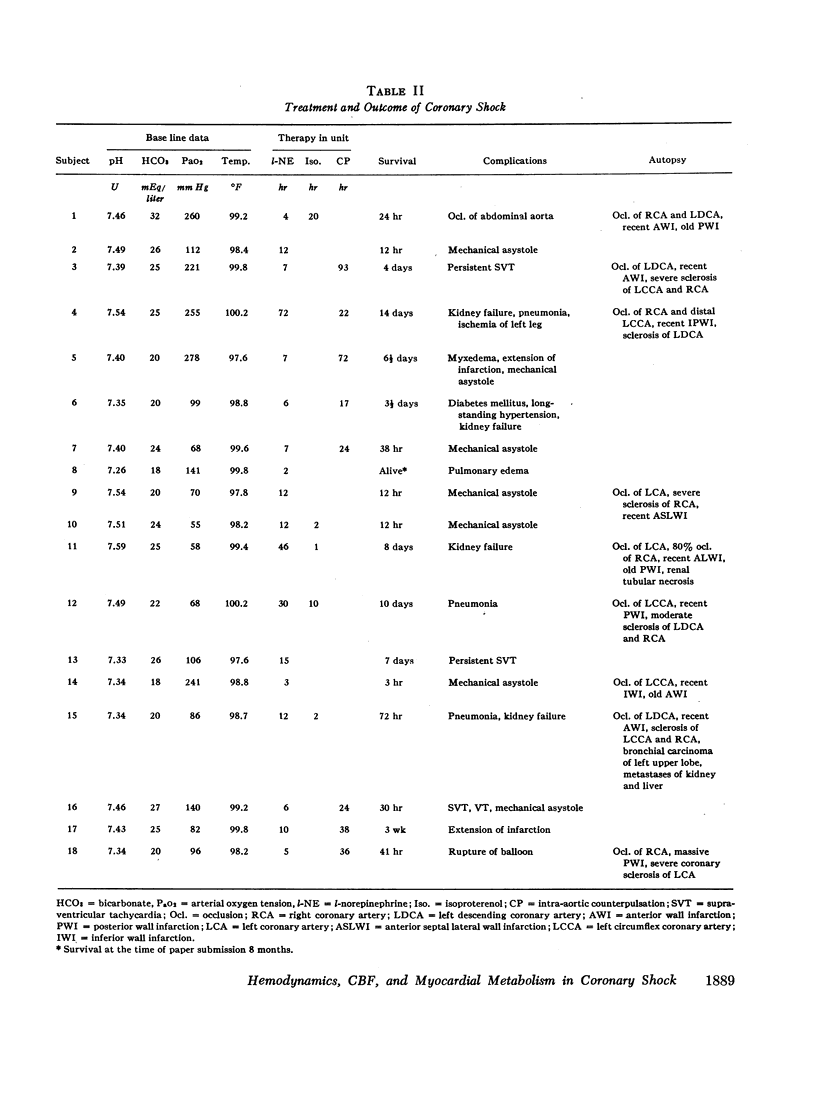
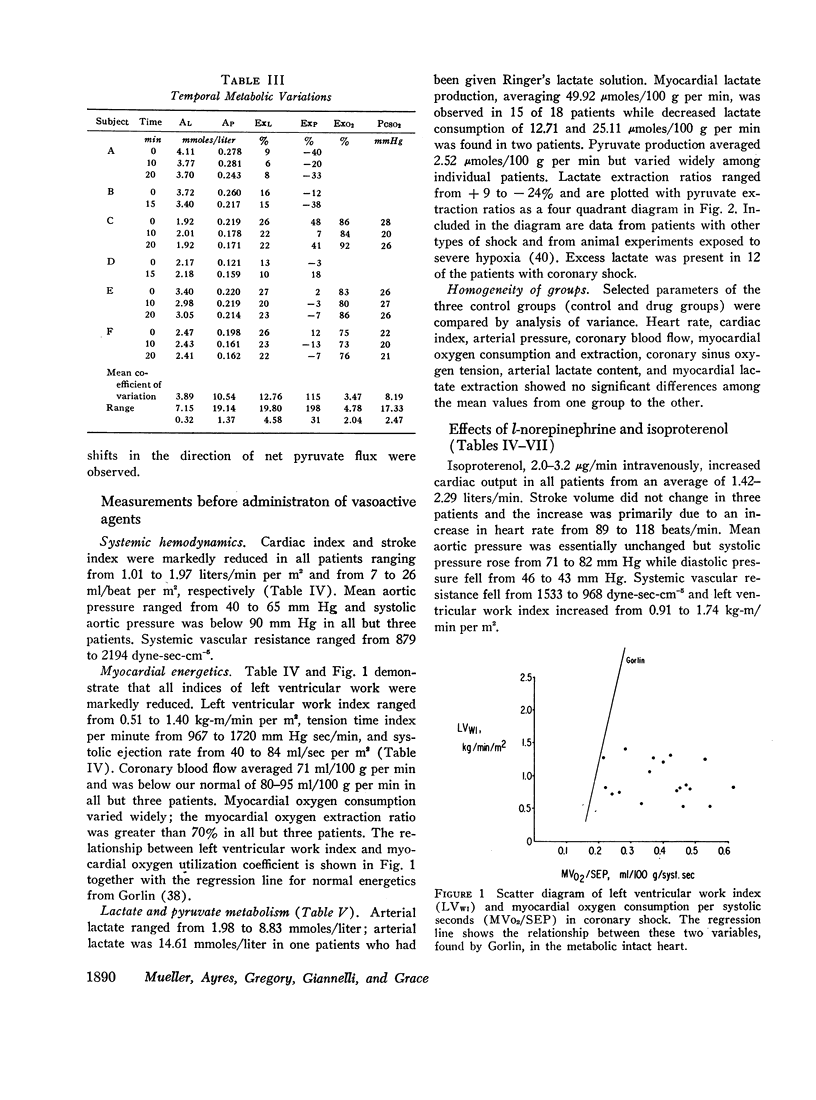
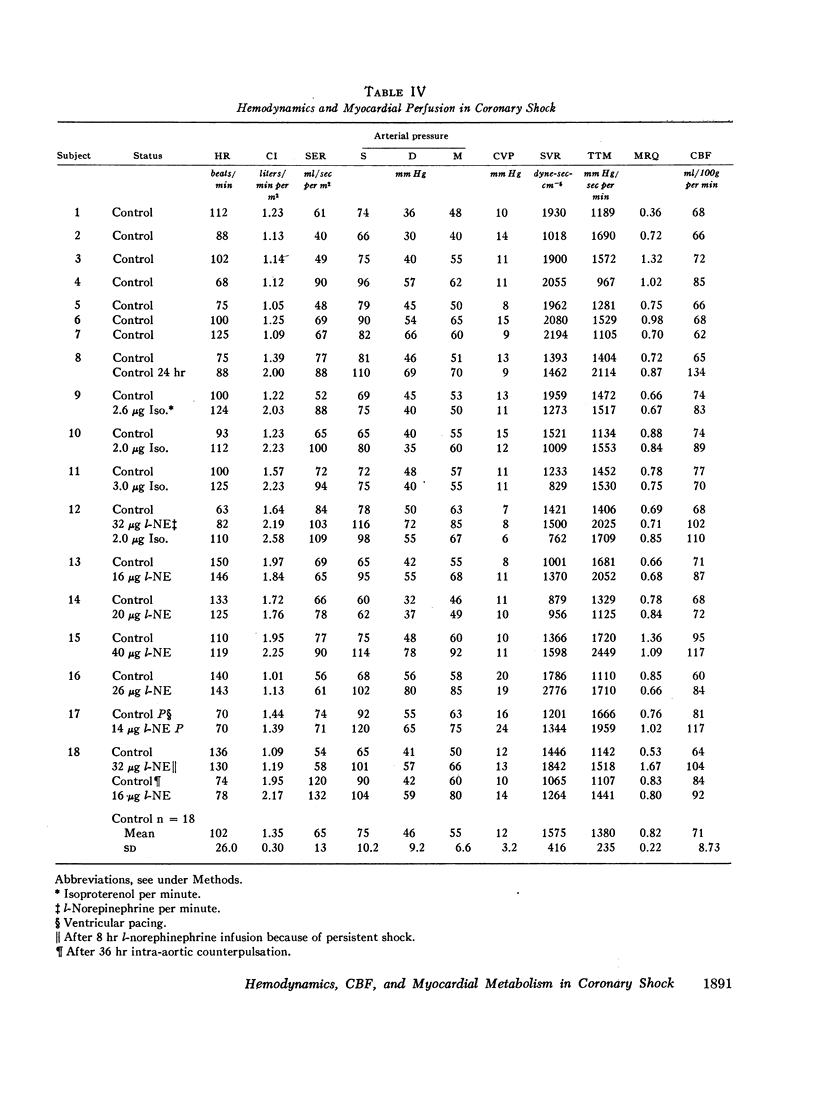
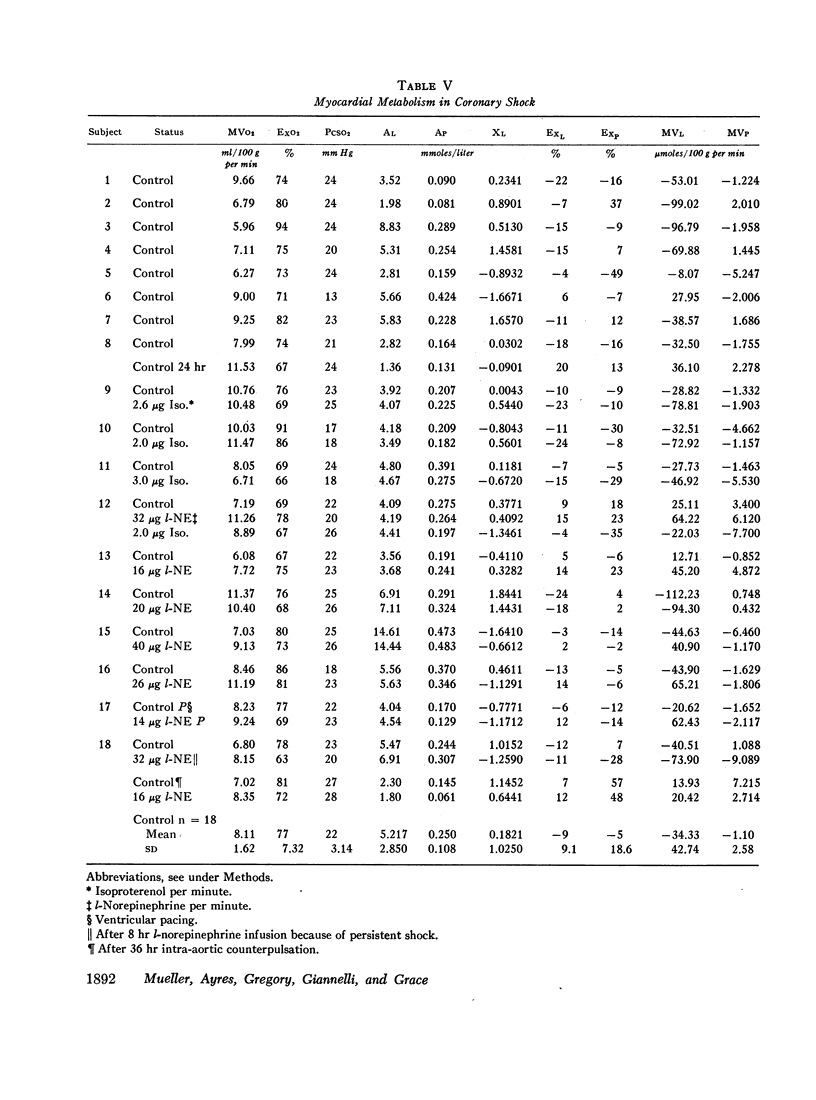
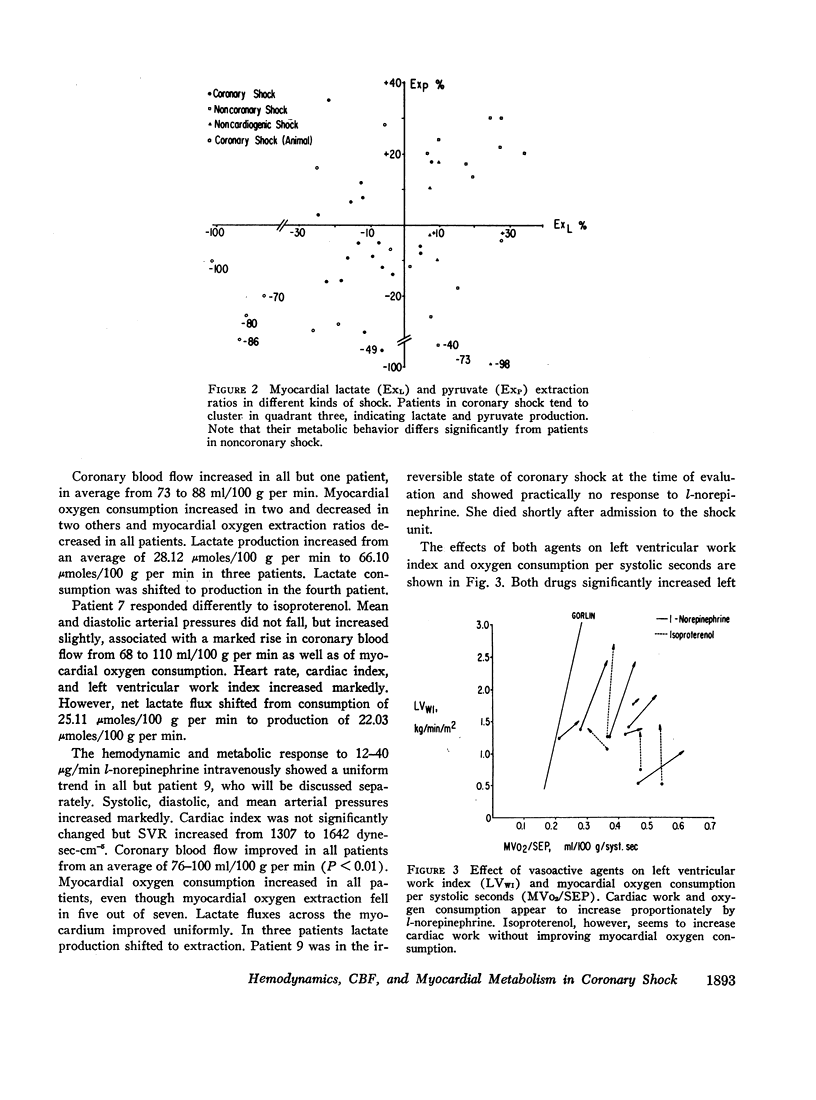

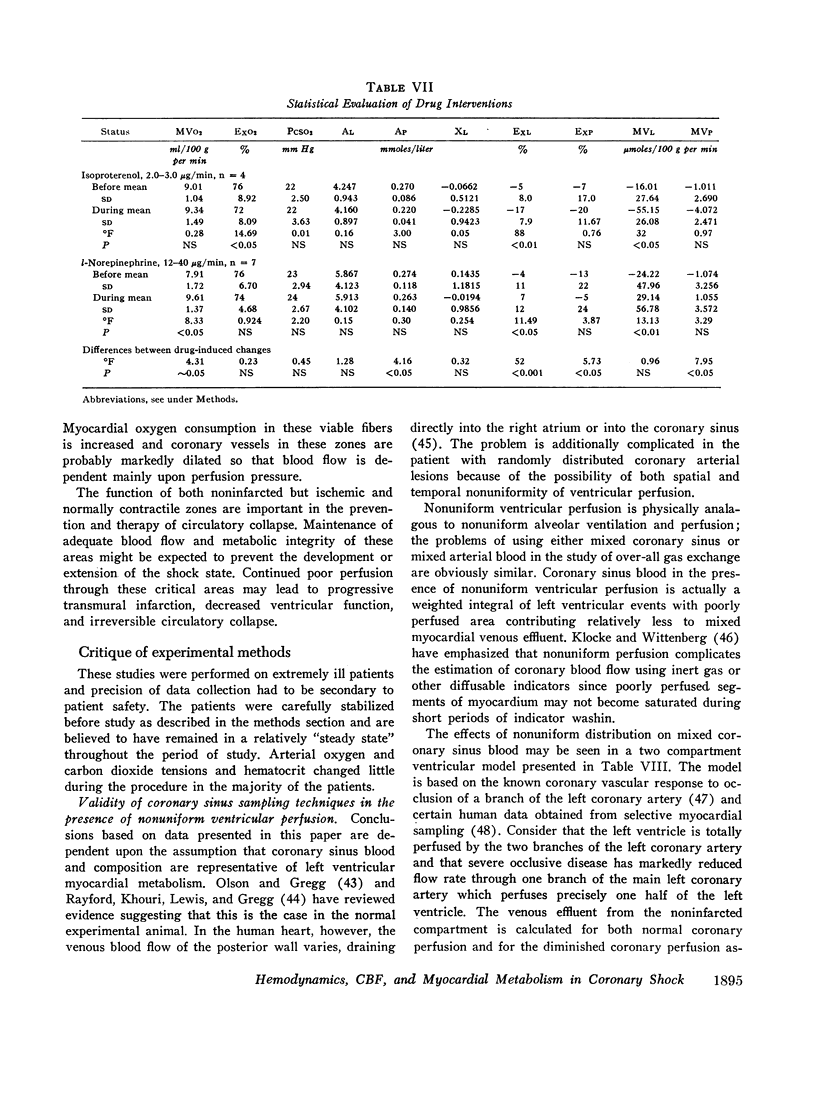
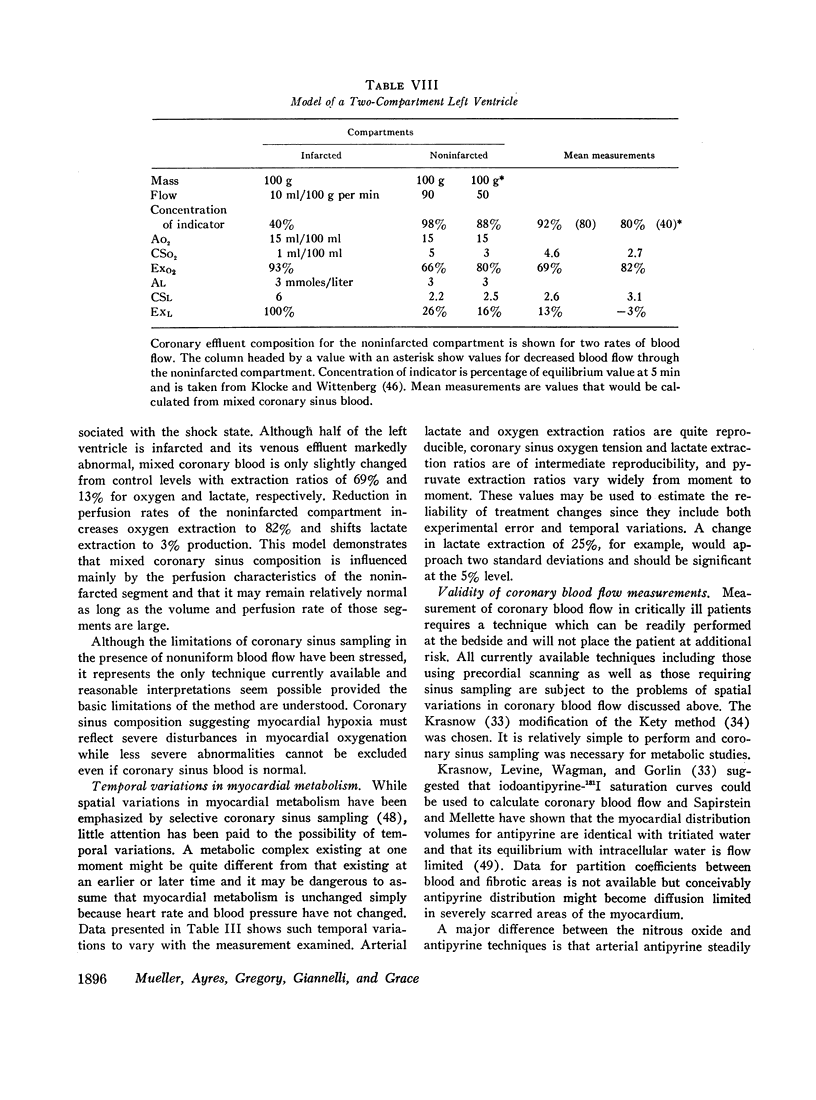
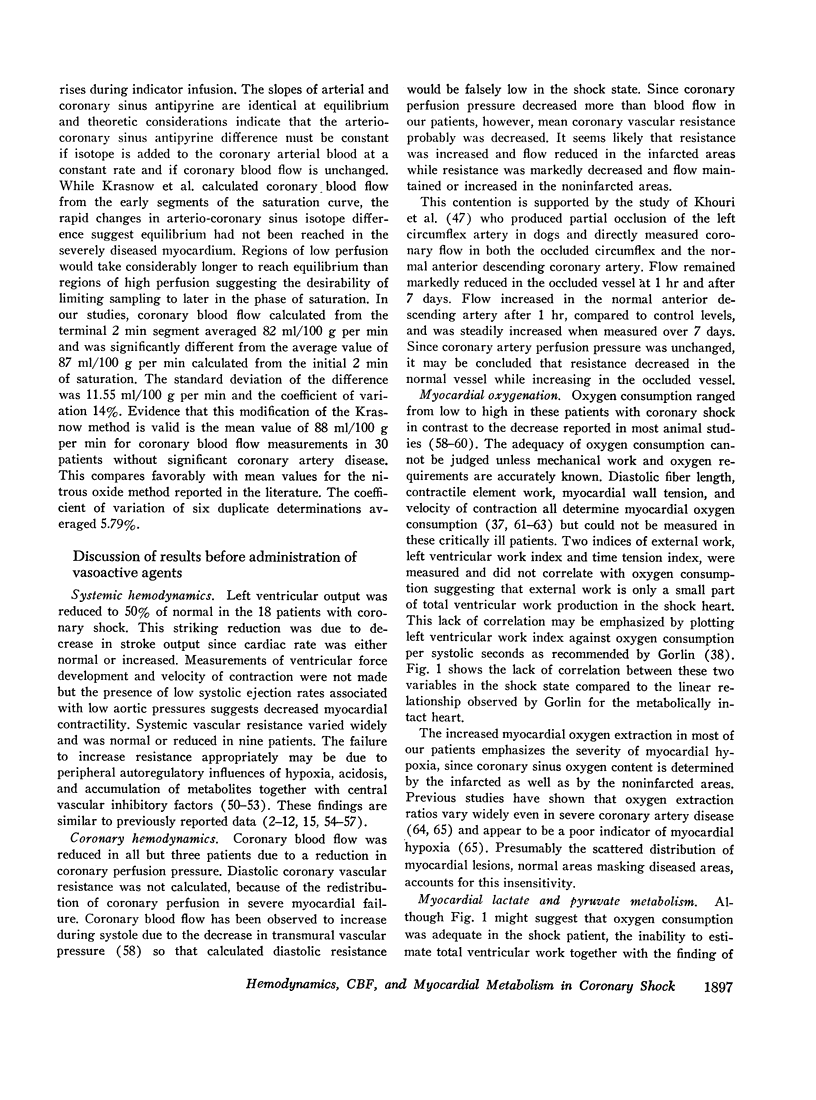
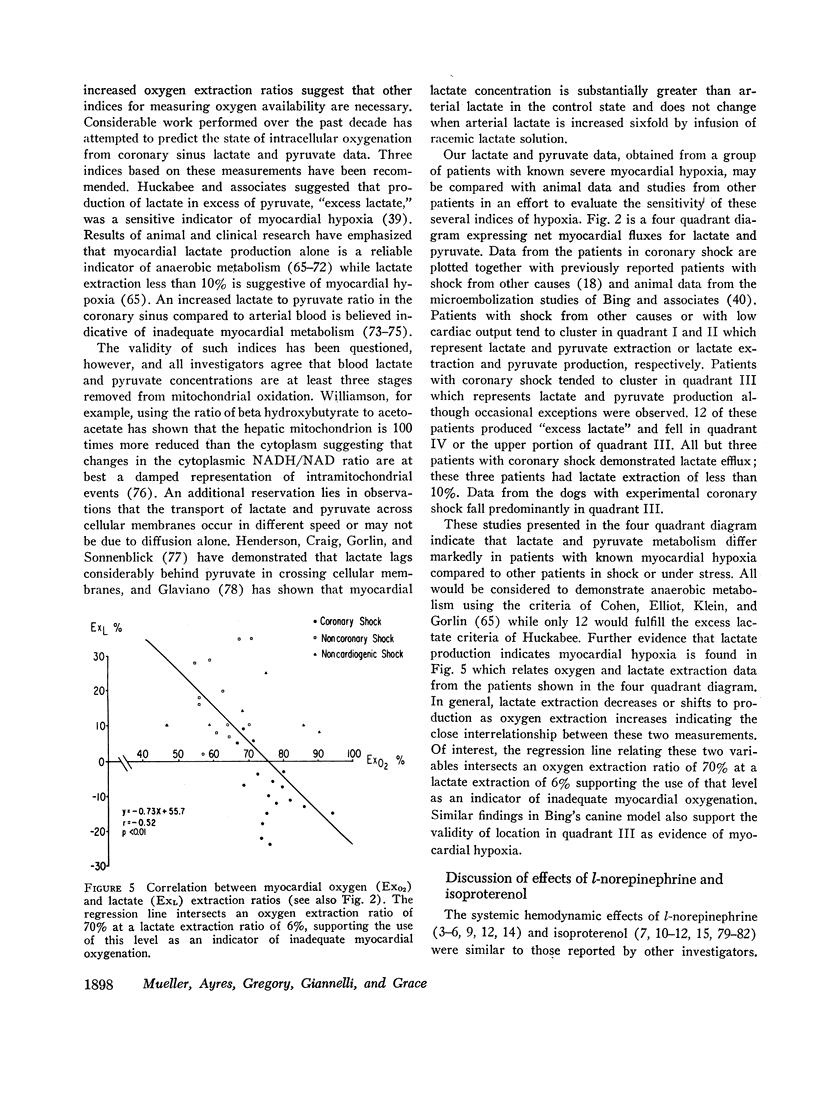
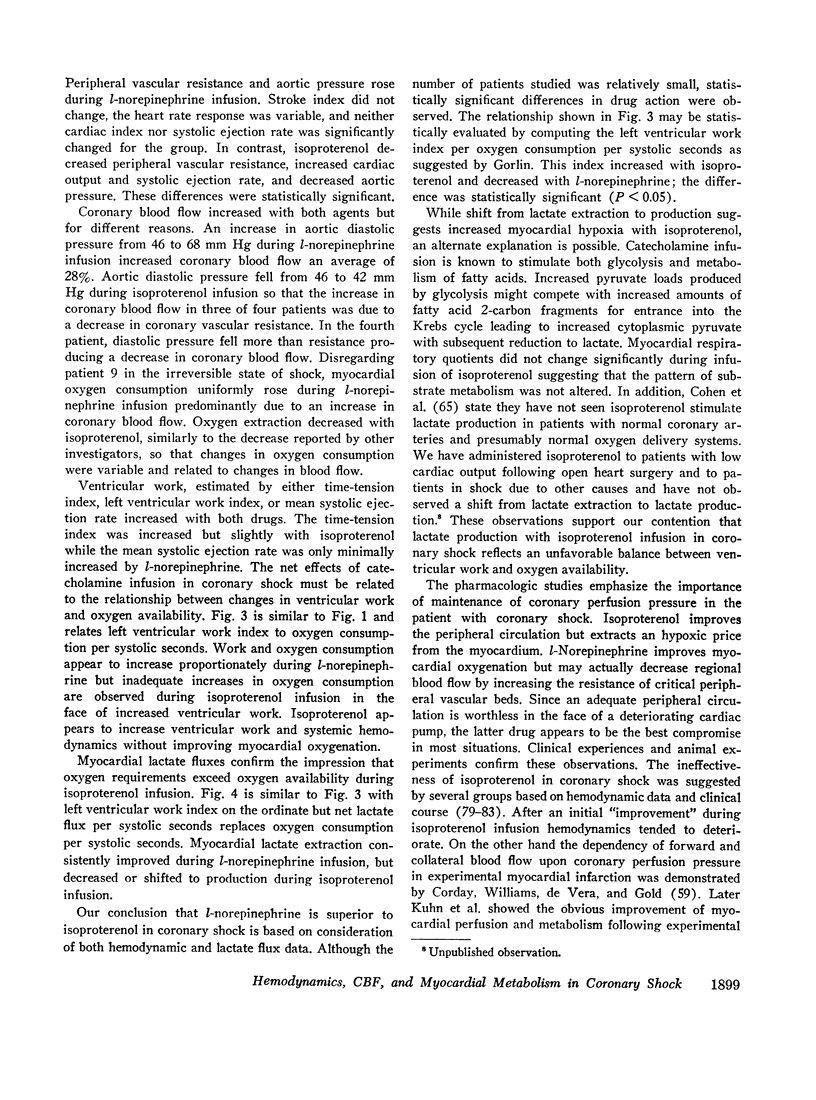
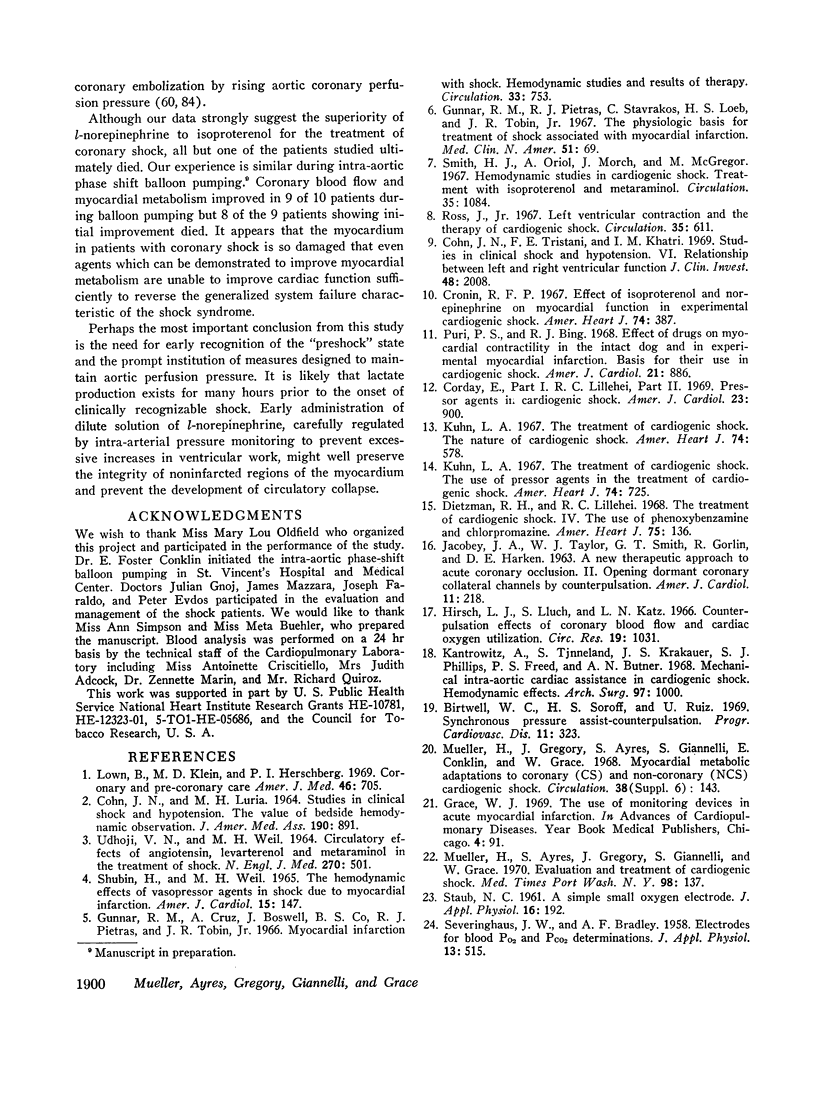
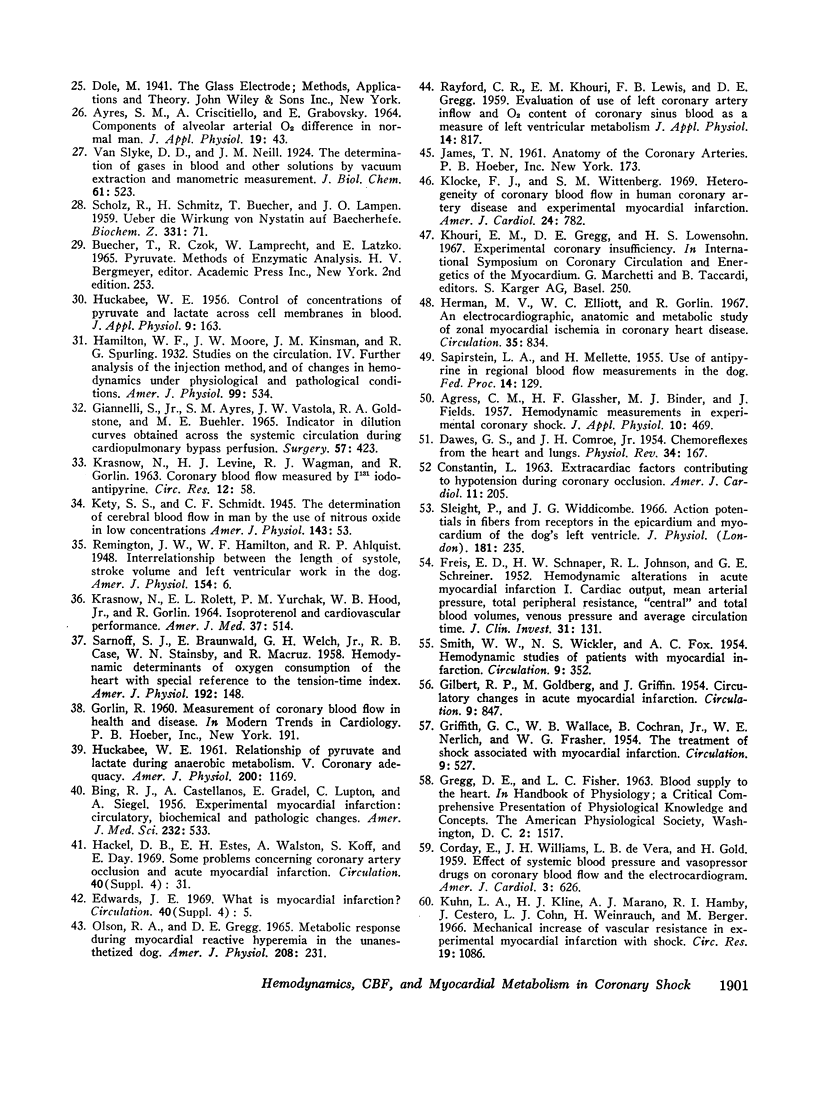
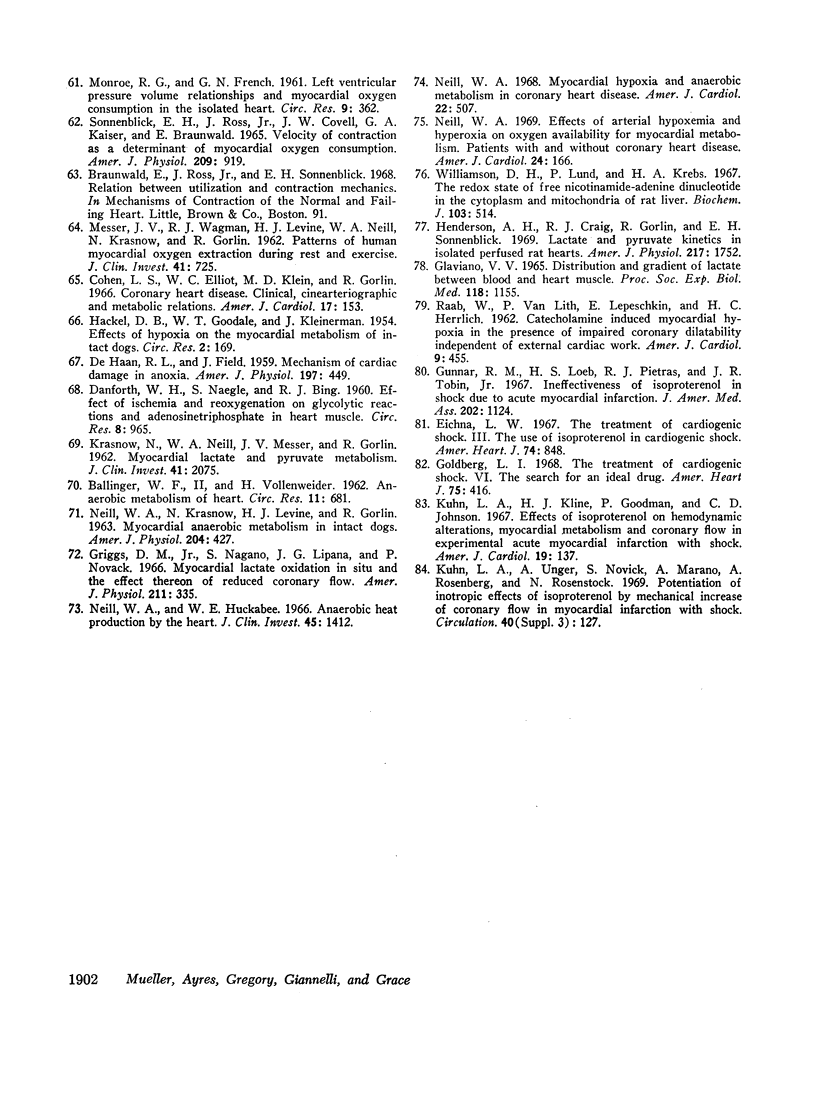
Selected References
These references are in PubMed. This may not be the complete list of references from this article.
- AGRESS C. M., GLASSNER H. F., BINDER M. J., FIELDS J. Hemodynamic measurements in experimental coronary shock. J Appl Physiol. 1957 May;10(3):469–475. doi: 10.1152/jappl.1957.10.3.469. [DOI] [PubMed] [Google Scholar]
- AYRES S. M., CRISCITIELLO A., GRABOVSKY E. COMPONENTS OF ALVEOLAR-ARTERIAL O2 DIFFERENCE IN NORMAL MAN. J Appl Physiol. 1964 Jan;19:43–47. doi: 10.1152/jappl.1964.19.1.43. [DOI] [PubMed] [Google Scholar]
- BALLINGER W. F., 2nd, TEMPLETON J. Y., 3rd, VOLLENWEIDER H. Anaerobic metabolism of heart. Circ Res. 1962 Oct;11:681–685. doi: 10.1161/01.res.11.4.681. [DOI] [PubMed] [Google Scholar]
- BING R. J., CASTELLANOS A., GRADEL E., LUPTON C., SIEGEL A. Experimental myocardial infarction: circulatory, biochemical and pathologic changes. Am J Med Sci. 1956 Nov;232(5):533–554. [PubMed] [Google Scholar]
- Birtwell W. C., Soroff H. S., Ruiz U., Many M., Giron F., Deterling R. A., Jr Synchronous pressure assist-counterpulsation. Prog Cardiovasc Dis. 1969 Jan;11(4):323–337. doi: 10.1016/0033-0620(69)90058-9. [DOI] [PubMed] [Google Scholar]
- COHN J. N., LURIA M. H. STUDIES IN CLINICAL SHOCK AND HYPOTENSION; THE VALUE OF BEDSIDE HEMODYNAMIC OBSERVATIONS. JAMA. 1964 Dec 7;190:891–896. [PubMed] [Google Scholar]
- CORDAY E., WILLIAMS J. H., DE VERA L. B., GOLD H. Effect of systemic blood pressure and vasopressor drugs on coronary blood flow and the electrocardiogram. Am J Cardiol. 1959 May;3(5):626–637. doi: 10.1016/0002-9149(59)90344-3. [DOI] [PubMed] [Google Scholar]
- COSTANTIN L. Extracardiac factors contributing to hypotension during coronary occlusion. Am J Cardiol. 1963 Feb;11:205–217. doi: 10.1016/0002-9149(63)90062-6. [DOI] [PubMed] [Google Scholar]
- Cohen L. S., Elliott W. C., Klein M. D., Gorlin R. Coronary heart disease. Clinical, cinearteriographic and metabolic correlations. Am J Cardiol. 1966 Feb;17(2):153–168. doi: 10.1016/0002-9149(66)90347-x. [DOI] [PubMed] [Google Scholar]
- Cohn J. N., Tristani F. E., Khatri I. M. Studies in clinical shock and hypotension: VI. Relationship between left and right ventricular function. J Clin Invest. 1969 Nov;48(11):2008–2018. doi: 10.1172/JCI106166. [DOI] [PMC free article] [PubMed] [Google Scholar]
- Corday E., Lillehei R. C. Pressor agents in cardiogenic shock. Am J Cardiol. 1969 Jun;23(6):900–910. doi: 10.1016/0002-9149(69)90389-0. [DOI] [PubMed] [Google Scholar]
- Cronin R. F. Effect of isoproterenol and norepinephrine on myocardial function in experimental cardiogenic shock. Am Heart J. 1967 Sep;74(3):387–395. doi: 10.1016/0002-8703(67)90079-8. [DOI] [PubMed] [Google Scholar]
- DANFORTH W. H., NAEGLE S., BING R. J. Effect of ischemia and reoxygenation on glycolytic reactions and adenosine-triphosphate in heart muscle. Circ Res. 1960 Sep;8:965–971. doi: 10.1161/01.res.8.5.965. [DOI] [PubMed] [Google Scholar]
- DAWES G. S., COMROE J. H., Jr Chemoreflexes from the heart and lungs. Physiol Rev. 1954 Apr;34(2):167–201. doi: 10.1152/physrev.1954.34.2.167. [DOI] [PubMed] [Google Scholar]
- DEHAAN R. L., FIELD J. Mechanism of cardiac damage in anoxia. Am J Physiol. 1959 Aug;197:449–453. doi: 10.1152/ajplegacy.1959.197.2.449. [DOI] [PubMed] [Google Scholar]
- Dietzman R. H., Lillehei R. C. The treatment of cardiogenic shock. IV. The use of phenoxybenzamine and chlorpromazine. Am Heart J. 1968 Jan;75(1):136–138. doi: 10.1016/0002-8703(68)90124-5. [DOI] [PubMed] [Google Scholar]
- FREIS E. D., SCHNAPER H. W., JOHNSON R. L., SCHREINER G. E. Hemodynamic alterations in acute myocardial infarction. I. Cardiac output, mean arterial pressure, total peripheral resistance, central and total blood volumes, venous pressure and average circulation time. J Clin Invest. 1952 Feb;31(2):131–140. doi: 10.1172/JCI102584. [DOI] [PMC free article] [PubMed] [Google Scholar]
- GIANNELLI S., Jr, AYRES S. M., VASTOLA J. W., GOLDSTONE R. A., BUEHLER M. E. INDICATOR-DILUTION CURVES OBTAINED ACROSS THE SYSTEMIC CIRCULATION DURING CARDIOPULMONARY BYPASS PERFUSION. Surgery. 1965 Mar;57:423–434. [PubMed] [Google Scholar]
- GILBERT R. P., GOLDBERG M., GRIFFIN J. Circulatory changes in acute myo cardial infarction. Circulation. 1954 Jun;9(6):847–852. doi: 10.1161/01.cir.9.6.847. [DOI] [PubMed] [Google Scholar]
- GLAVIANO V. V. DISTRIBUTION AND GRADIENT OF LACTATE BETWEEN BLOOD AND HEART MUSCLE. Proc Soc Exp Biol Med. 1965 Apr;118:1155–1158. doi: 10.3181/00379727-118-30068. [DOI] [PubMed] [Google Scholar]
- GRIFFITH G. C., WALLACE W. B., COCHRAN B., Jr, NERLICH W. E., FRASHER W. E. The treatment of shock associated with myocardial infarction. Circulation. 1954 Apr;9(4):527–532. doi: 10.1161/01.cir.9.4.527. [DOI] [PubMed] [Google Scholar]
- Goldberg L. I. The treatment of cardiogenic shock. VI. The search for an ideal drug. Am Heart J. 1968 Mar;75(3):416–420. doi: 10.1016/0002-8703(68)90098-7. [DOI] [PubMed] [Google Scholar]
- Griggs D. M., Jr, Nagano S., Lipana J. G., Novack P. Myocardial lactate oxidation in situ and the effect thereon of reduced coronary flow. Am J Physiol. 1966 Aug;211(2):335–340. doi: 10.1152/ajplegacy.1966.211.2.335. [DOI] [PubMed] [Google Scholar]
- Gunnar R. M., Cruz A., Boswell J., Co B. S., Pietras R. J., Tobin J. R., Jr Myocardial infarction with shock. Hemodynamic studies and results of therapy. Circulation. 1966 May;33(5):753–762. doi: 10.1161/01.cir.33.5.753. [DOI] [PubMed] [Google Scholar]
- Gunnar R. M., Loeb H. S., Pietras R. J., Tobin J. R., Jr Ineffectiveness of isoproterenol in shock due to acute myocardial infarction. JAMA. 1967 Dec 25;202(13):1124–1128. [PubMed] [Google Scholar]
- Gunnar R. M., Pietras R. J., Stavrakos C., Loeb H. S., Tobin J. R., Jr The physiologic basis for treatment of shock associated with myocardial infarction. Med Clin North Am. 1967 Jan;51(1):69–81. doi: 10.1016/s0025-7125(16)33083-8. [DOI] [PubMed] [Google Scholar]
- HACKEL D. B., GOODALE W. T., KLEINERMAN J. Effects of hypoxia on the myocardial metabolism of intact dogs. Circ Res. 1954 Mar;2(2):169–174. doi: 10.1161/01.res.2.2.169. [DOI] [PubMed] [Google Scholar]
- HUCKABEE W. E. Control of concentration gradients of pyruvate and lactate across cell membranes in blood. J Appl Physiol. 1956 Sep;9(2):163–170. doi: 10.1152/jappl.1956.9.2.163. [DOI] [PubMed] [Google Scholar]
- HUCKABEE W. E. Relationship of pyruvate and lactate during anaerobic metabolism. V. Coronary adequacy. Am J Physiol. 1961 Jun;200:1169–1176. doi: 10.1152/ajplegacy.1961.200.6.1169. [DOI] [PubMed] [Google Scholar]
- Henderson A. H., Craig R. J., Gorlin R., Sonnenblick E. H. Lactate and pyruvate kinetics in isolated perfused rat hearts. Am J Physiol. 1969 Dec;217(6):1752–1756. doi: 10.1152/ajplegacy.1969.217.6.1752. [DOI] [PubMed] [Google Scholar]
- Herman M. V., Elliott W. C., Gorlin R. An electrocardiographic, anatomic, and metabolic study of zonal myocardial ischemia in coronary heart disease. Circulation. 1967 May;35(5):834–846. doi: 10.1161/01.cir.35.5.834. [DOI] [PubMed] [Google Scholar]
- Hirsch L. J., Lluch S., Katz L. N. Counterpulsation effects of coronary blood flow and cardiac oxygen utilization. Circ Res. 1966 Dec;19(6):1031–1040. doi: 10.1161/01.res.19.6.1031. [DOI] [PubMed] [Google Scholar]
- KRASNOW N., LEVINE H. J., WAGMAN R. J., GORLIN R. Coronary blood flow measured by I-131 iodo-antipyrine. Circ Res. 1963 Jan;12:58–62. doi: 10.1161/01.res.12.1.58. [DOI] [PubMed] [Google Scholar]
- KRASNOW N., NEILL W. A., MESSER J. V., GORLIN R. Myocardial lactate and pyruvate metabolism. J Clin Invest. 1962 Nov;41:2075–2085. doi: 10.1172/JCI104665. [DOI] [PMC free article] [PubMed] [Google Scholar]
- KRASNOW N., ROLETT E. L., YURCHAK P. M., HOOD W. B., Jr, GORLIN R. ISOPROTERENOL AND CARDIOVASCULAR PERFORMANCE. Am J Med. 1964 Oct;37:514–525. doi: 10.1016/0002-9343(64)90065-8. [DOI] [PubMed] [Google Scholar]
- Kantrowitz A., Tjonneland S., Krakauer J. S., Phillips S. J., Freed P. S., Butner A. N. Mechanical intraaortic cardiac assistance in cardiogenic shock. Hemodynamic effects. Arch Surg. 1968 Dec;97(6):1000–1004. doi: 10.1001/archsurg.1968.01340060178021. [DOI] [PubMed] [Google Scholar]
- Klocke F. J., Wittenberg S. M. Heterogeneity of coronary blood flow in human coronary artery disease and experimental myocardial infarction. Am J Cardiol. 1969 Dec;24(6):782–790. doi: 10.1016/0002-9149(69)90467-6. [DOI] [PubMed] [Google Scholar]
- Kuhn L. A., Kline H. J., Marano A. J., Hamby R. I., Cestero J., Cohn L. J., Weinrauch H., Berger M. Mechanical increase of vascular resistance in experimental myocardial infarction with shock. Circ Res. 1966 Dec;19(6):1086–1096. doi: 10.1161/01.res.19.6.1086. [DOI] [PubMed] [Google Scholar]
- Kuhn L. A. The treatment of cardiogenic shock. I. The nature of cardiogenic shock. Am Heart J. 1967 Oct;74(4):578–581. doi: 10.1016/0002-8703(67)90019-1. [DOI] [PubMed] [Google Scholar]
- Kuhn L. A. The treatment of cardiogenic shock. II. The use of pressor agents in the treatment of cardiogenic shock. Am Heart J. 1967 Nov;74(5):725–728. doi: 10.1016/0002-8703(67)90511-x. [DOI] [PubMed] [Google Scholar]
- Lown B., Klein M. D., Hershberg P. I. Coronary and precoronary care. Am J Med. 1969 May;46(5):705–724. doi: 10.1016/0002-9343(69)90022-9. [DOI] [PubMed] [Google Scholar]
- MESSER J. V., WAGMAN R. J., LEVINE H. J., NEILL W. A., KRASNOW N., GORLIN R. Patterns of human myocardial oxygen extraction during rest and exercise. J Clin Invest. 1962 Apr;41:725–742. doi: 10.1172/JCI104531. [DOI] [PMC free article] [PubMed] [Google Scholar]
- MONROE R. G., FRENCH G. N. Left ventricular pressure-volume relationships and myocardial oxygen consumption in the isolated heart. Circ Res. 1961 Mar;9:362–374. doi: 10.1161/01.res.9.2.362. [DOI] [PubMed] [Google Scholar]
- Mueller H. S., Ayres S. M., Gregory J. J., Giannelli S., Jr, Grace W. J. The evaluation and treatment of cardiogenic shock. Med Times. 1970 Jul;98(7):137–152. [PubMed] [Google Scholar]
- NEILL W. A., KRASNOW N., LEVINEHJ, GORLIN R. Myocardial anaerobic metabolism in intact dogs. Am J Physiol. 1963 Mar;204:427–432. doi: 10.1152/ajplegacy.1963.204.3.427. [DOI] [PubMed] [Google Scholar]
- Neill W. A. Effects of arterial hypoxemia and hyperoxia on oxygen availability for myocardial metabolism. Patients with and without coronary heart disease. Am J Cardiol. 1969 Aug;24(2):166–171. doi: 10.1016/0002-9149(69)90399-3. [DOI] [PubMed] [Google Scholar]
- Neill W. A., Huckabee W. E. Anaerobic heat production by the heart. J Clin Invest. 1966 Sep;45(9):1412–1420. doi: 10.1172/JCI105449. [DOI] [PMC free article] [PubMed] [Google Scholar]
- Neill W. A. Myocardial hypoxia and anerobic metabolism in coronary heart disease. Am J Cardiol. 1968 Oct;22(4):507–515. doi: 10.1016/0002-9149(68)90155-0. [DOI] [PubMed] [Google Scholar]
- OLSSON R. A., GREGG D. E. METABOLIC RESPONSES DURING MYOCARDIAL REACTIVE HYPEREMIA IN THE UNANESTHETIZED DOG. Am J Physiol. 1965 Feb;208:231–236. doi: 10.1152/ajplegacy.1965.208.2.231. [DOI] [PubMed] [Google Scholar]
- Puri P. S., Bing R. J. Effect of drugs on myocardial contractility in the intact dog and in experimental myocardial infarction. Am J Cardiol. 1968 Jun;21(6):886–893. doi: 10.1016/0002-9149(68)90307-x. [DOI] [PubMed] [Google Scholar]
- RAAB W., VAN LITH P., LEPESCHKIN E., HERRLICH H. C. Catecholamine-induced myocardial hypoxia in the presence of impaired coronary dilatability independent of external cardiac work. Am J Cardiol. 1962 Mar;9:455–470. doi: 10.1016/0002-9149(62)90163-7. [DOI] [PubMed] [Google Scholar]
- RAYFORD C. R., KHOURI E. M., LEWIS F. B., GREGG D. E. Evaluation of use of left coronary artery inflow and O2 content of coronary sinus blood as a measure of left ventricular metabolism. J Appl Physiol. 1959 Sep;14:817–822. doi: 10.1152/jappl.1959.14.5.817. [DOI] [PubMed] [Google Scholar]
- Ross J., Jr Left ventricular contraction and the therapy of cardiogenic shock. Circulation. 1967 Apr;35(4):611–613. doi: 10.1161/01.cir.35.4.611. [DOI] [PubMed] [Google Scholar]
- SARNOFF S. J., BRAUNWALD E., WELCH G. H., Jr, CASE R. B., STAINSBY W. N., MACRUZ R. Hemodynamic determinants of oxygen consumption of the heart with special reference to the tension-time index. Am J Physiol. 1958 Jan;192(1):148–156. doi: 10.1152/ajplegacy.1957.192.1.148. [DOI] [PubMed] [Google Scholar]
- SEVERINGHAUS J. W., BRADLEY A. F. Electrodes for blood pO2 and pCO2 determination. J Appl Physiol. 1958 Nov;13(3):515–520. doi: 10.1152/jappl.1958.13.3.515. [DOI] [PubMed] [Google Scholar]
- SMITH W. W., WIKLER N. S., FOX A. C. Hemodynamic studies of patients with myocardial infarction. Circulation. 1954 Mar;9(3):352–362. doi: 10.1161/01.cir.9.3.352. [DOI] [PubMed] [Google Scholar]
- Sleight P., Widdicombe J. G. Action potentials in fibres from receptors in the epicardium and myocardium of the dog's left ventricle. J Physiol. 1965 Nov;181(2):235–258. doi: 10.1113/jphysiol.1965.sp007758. [DOI] [PMC free article] [PubMed] [Google Scholar]
- Smith H. J., Oriol A., Morch J., McGregor M. Hemodynamic studies in cardiogenic shock. Treatment with isoproterenol and metaraminol. Circulation. 1967 Jun;35(6):1084–1091. doi: 10.1161/01.cir.35.6.1084. [DOI] [PubMed] [Google Scholar]
- Sonnenblick E. H., Ross J., Jr, Covell J. W., Kaiser G. A., Braunwald E. Velocity of contraction as a determinant of myocardial oxygen consumption. Am J Physiol. 1965 Nov;209(5):919–927. doi: 10.1152/ajplegacy.1965.209.5.919. [DOI] [PubMed] [Google Scholar]
- UDHOJI V. N., WEIL M. H. CIRCULATORY EFFECTS OF ANGIOTENSIN, LEVARTERENOL AND METARAMINOL IN THE TREATMENT OF SHOCK. N Engl J Med. 1964 Mar 5;270:501–505. doi: 10.1056/NEJM196403052701004. [DOI] [PubMed] [Google Scholar]
- Viles P. H., Ongley P. A., Titus J. L. The spectrum of pulmonary vascular disease in transposition of the great arteries. Circulation. 1969 Jul;40(1):31–41. doi: 10.1161/01.cir.40.1.31. [DOI] [PubMed] [Google Scholar]
- Williamson D. H., Lund P., Krebs H. A. The redox state of free nicotinamide-adenine dinucleotide in the cytoplasm and mitochondria of rat liver. Biochem J. 1967 May;103(2):514–527. doi: 10.1042/bj1030514. [DOI] [PMC free article] [PubMed] [Google Scholar]


